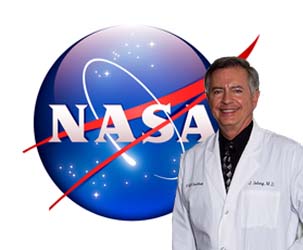
30 Oct Dr. Sebag Collaborates with NASA
Advances in our ability to diagnose and treat diseases of the vitreous, macula, and retina depend upon collaboration between scientists and clinicians.
During a 12 year period, Dr. Sebag conducted research in collaboration with Dr. Rafat Ansari of the NASA Glenn Research Center in Cleveland, Ohio.  The objective was to develop laser-based nanotechnologies to measure various things in the eye, such as the size(s) of molecules in the lens and vitreous [link to the pdf of the publication: Ansari RR, Dunker S, Suh K, Kitaya N, Sebag J: Quantitative molecular characterization of bovine vitreous and lens with non-invasive dynamic light scattering. Exp Eye Res 73:859-866, 2001], or the blood flow in the eye. This latter technology was developed in Cleveland and tested in Houston at NASA’s Johnson Space Center, as shown in this video. Non-invasive technologies are important in Medicine and the the eye offers a unique opportunity to use laser light because it can enter the eye and be reflected back out without damaging the eye. Capturing and analyzing the light that is reflected back out of the eye can tell scientists and clinicians much about the health of the eye.
The objective was to develop laser-based nanotechnologies to measure various things in the eye, such as the size(s) of molecules in the lens and vitreous [link to the pdf of the publication: Ansari RR, Dunker S, Suh K, Kitaya N, Sebag J: Quantitative molecular characterization of bovine vitreous and lens with non-invasive dynamic light scattering. Exp Eye Res 73:859-866, 2001], or the blood flow in the eye. This latter technology was developed in Cleveland and tested in Houston at NASA’s Johnson Space Center, as shown in this video. Non-invasive technologies are important in Medicine and the the eye offers a unique opportunity to use laser light because it can enter the eye and be reflected back out without damaging the eye. Capturing and analyzing the light that is reflected back out of the eye can tell scientists and clinicians much about the health of the eye.
This video was produced by ABC 13 News in Houston, Texas. The interviews were taped immediately following a test flight during which Dr. Sebag and Dr. Ansari conducted research on the effects of zero gravity on blood flow in the eye. The experimental setting of zero G and 2-G was created on a plane called KC-135 or the “vomit comet”. When it dropped in free fall from an altitude of 39,000 feet to 10,000 feet, weightlessness was created for a period of about 25 seconds. When the plane bottomed out and started to climb, 2-G effects were created.

